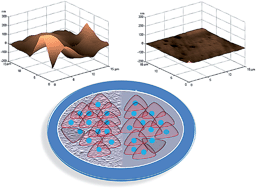An in vitro study on the collective tumor cell migration on nanoroughened poly(dimethylsiloxane) surfaces†
Abstract
The nanotopography of the cellular environment in vivo is an important factor that affects cellular phenomena such as adhesion, proliferation and migration. The capability of tumor cells to collectively migrate is critical during the process of tumor metastasis, which is significantly regulated by the nanotopography of the microenvironment such as its roughness. Herein, a simple and effective approach is developed to generate a controlled roughness contrast on the same poly(dimethylsiloxane) substrate using chemical etching and rapid molding, and a quantitative study is presented on the influence of surface roughness on cell collective migration. Specifically, the HuH7 (a human hepatocarcinoma) cell monolayer exhibits a slower migration mode on a nanoroughened substrate compared to its behaviour on a smooth substrate. Subsequent gene analyses indicate that the cell-substrate and cell-cell adhesion proteins are downregulated on the roughened substrate. This study shows the impact of substrate roughness on cell biochemical functioning, and hence on collective migration, suggesting that an engineered nanotopography could be applied in the design of biomedical devices in order to manipulate tumor cell behaviour.


 Please wait while we load your content...
Please wait while we load your content...